Senior perk
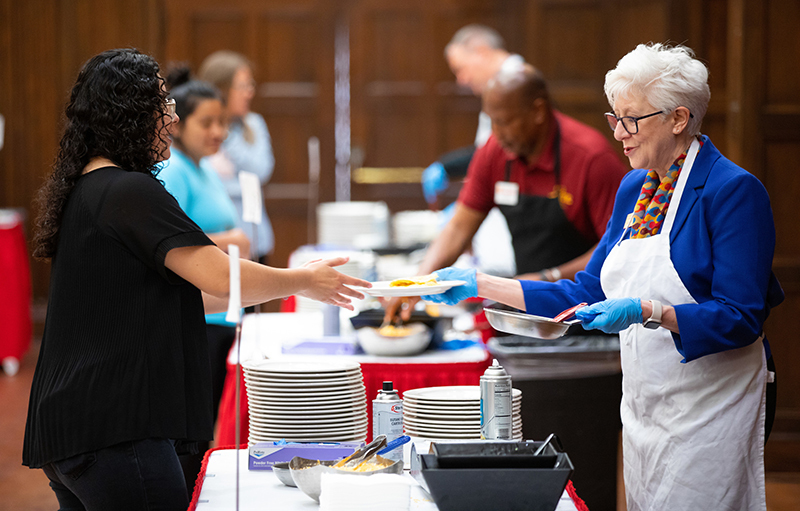
Photo by Christopher Gannon.
College of Human Sciences dean Laura Jolly (right) serves an omelette to senior Emily Albarran of Marshalltown during the senior breakfast Tuesday morning in the Memorial Union Great Hall. Graduating seniors were invited to enjoy a full breakfast menu as part of senior week, sponsored by the Student Alumni Leadership Council. Jolly was one of about 35 administrator, faculty and staff volunteers, working as omelet makers and table servers, who contributed to this annual event.
Congratulations, faculty promotion recipients
In all, 122 Iowa State faculty received promotions, including tenure, this spring.
The state Board of Regents approved tenure and faculty promotion requests for the 2024-25 academic year at its April 25 meeting. Iowa State's faculty list featured 66 cases: 24 requests for promotion to associate professor with tenure, and 42 requests for promotion to full professor for previously tenured faculty. The list includes 31 women and 25 men across all seven colleges. Last year, 75 Iowa State faculty received a promotion and/or tenure.
The full list of this spring's faculty promotions is posted on the provost's website.
2024-25 faculty promotions
|
College |
To associate professor with tenure |
To professor |
Total |
|
Agriculture and Life Sciences |
3 |
6 |
9 |
|
Business |
2 |
5 |
7 |
|
Design |
3 |
1 |
4 |
|
Engineering |
3 |
9 |
12 |
|
Human Sciences |
3 |
5 |
8 |
|
Liberal Arts and Sciences |
8 |
15 |
23 |
|
Veterinary Medicine |
2 |
1 |
3 |
|
Total |
24 |
42 |
66 |
Term faculty promotions
Also this week, the provost's office posted promotions for 56 term faculty for the 2024-25 academic year. Term faculty promotions don't require the regents' approval; the university president gives the final approval.
The promotions span six colleges and include 25 cases of advancement to the professor level and 29 cases to the associate professor level. They include four of the five professional tracks in Iowa State's five-year-old term faculty system: teaching, clinical, practice and adjunct. The fifth is a research track.
Last year, 37 term faculty received promotions.
2024-25 term faculty promotions
|
College |
To associate professor |
To professor |
Other |
Total |
|
Agriculture and Life Sciences |
4 |
0 |
1 |
5 |
|
Business |
5 |
0 |
0 |
5 |
|
Engineering |
3 |
4 |
1 |
8 |
|
Human Sciences |
5 |
4 |
0 |
9 |
|
Liberal Arts and Sciences |
8 |
15 |
0 |
23 |
|
Veterinary Medicine |
4 |
2 |
0 |
6 |
|
Total |
29 |
25 |
2 |
56 |
In the October 2023 employee headcount, Iowa State employed 606 term faculty and 1,140 tenured or tenure-track faculty.
Planning begins to improve Lake LaVerne
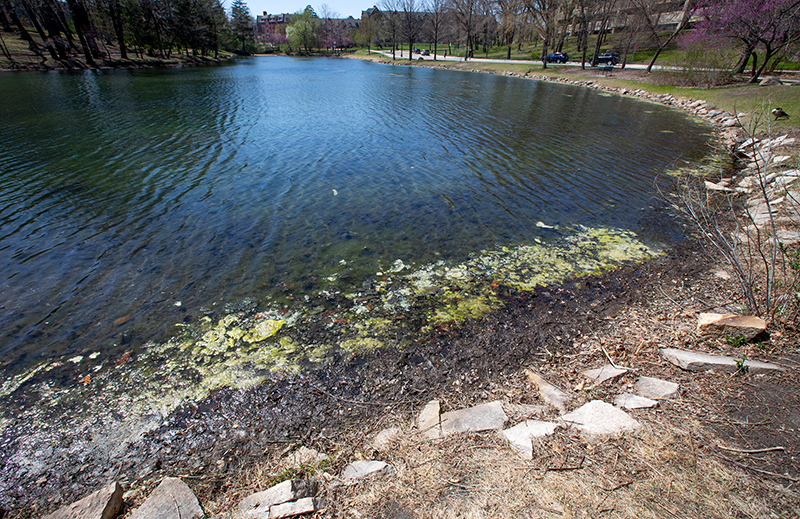
Draining and mechanically removing several feet of bottom sediment from Lake LaVerne would address two issues: shallow water depths and phosphorus levels in the water. Photos by Christopher Gannon.
Design work begins this spring on a plan to restore and improve Lake LaVerne. The project would remove decades of bottom sediment to increase water depth, stabilize the erosion-prone shoreline and address the areas immediately surrounding the lake, where runoff is a contributor to water quality. The restoration also would address some infrastructure needs, including improvements to the concrete outlet in the southeast corner and safety improvements along the gravel path south of the lake.
Consultants from Shive-Hattery will follow up with the design phase. They were on the team that completed a six-month study of the lake in 2022, mapping water and sediment depths and analyzing water samples. President Wendy Wintersteen reviewed the report from that study and greenlighted the design phase, which will take four to five months and cost about $125,000. Donor funds will cover the design phase.
Lake management plan
Physical improvements aren't the only change coming. Campus planner Chris Strawhacker, facilities planning and management, who coordinated the 2022 lake study, said a university team of faculty, researchers and FPM professionals will be assembled to systematically assess the lake and recommend actions as issues arise. With expertise in areas such as water quality, plant habitat and wildlife, the team would develop an adaptive management plan to elevate and maintain the quality and functionality of the lake. Faculty members from the group also assisted with the 2022 study and will be involved in the lake restoration design as needed.
A lake by name
Strawhacker emphasized that the intent of the restoration -- and the management plan -- is to maintain campus aesthetics and steward a 100-plus-year-old campus icon. It's not about creating a recreational hot spot for fishing or swimming.
Yes, swans will be back
Campus planner Chris Strawhacker said a pair of swans, Lancelot and Elaine -- another Iowa State tradition going back to 1935 -- will return to Lake LaVerne. A new duo will arrive once the lake restoration is complete, though that project timeline isn't known yet.
"We want our Iowa State community to have realistic expectations about what Lake LaVerne could be following restoration," Strawhacker said. "For example, plant growth is important to a healthy lake ecosystem, so we'll always have aquatic plants and algae growing in the lake. But by making improvements, we can make this small ecosystem healthier and visually more appealing."
The lake and the swans who roam it are beloved university traditions with alumni and students -- and will be maintained, he said.
"We also think that a team of experts, meeting regularly to assess and discuss changes in the lake as they're occurring, will contribute to the long-term health of the water and the plants and animals in it," he added.
One misperception about Lake LaVerne may be where its water comes from. The lake isn't fed by a creek or underground spring, and it's not even a dammed stream anymore, which is how it originated in 1916. It relies on precipitation, a well near the southwest corner and roof runoff from two adjacent buildings for water.
Lake LaVerne was created with a $10,000 donation from LaVerne Noyes, an alumnus from Iowa State's first graduating class of 1872. A dam constructed on College Creek flooded a 2.5-acre marsh in what now is the east end of the lake. In the 1930s, the creek was separated from the lake and still runs in a mostly underground channel from Welch Road to the east side of the Memorial Union parking ramp. In the 1930s, 1950s and 1990s, the lake was dredged, but not drained. The university made other changes over the decades to try to manage the sediment and water nutrient levels, for example, reinforcing the north shoreline, preventing street stormwater from draining into it and adding multiple aerators.
Shrinking watershed
From a watershed perspective, the lake's evolution over more than a century has been dramatic, Strawhacker said. In 1916, the lake's watershed was about 2,000 acres. When College Creek flow bypassed the lake in the 1930s, the watershed shrunk to 35 acres. Currently, the lake's watershed is about eight acres.
"We see it as a lake, but it functions more like an aquarium, with a little inflow and very little outflow," he said. "That's part of our management challenge, and it's a unique one."
Highlights of the 2022 lake study
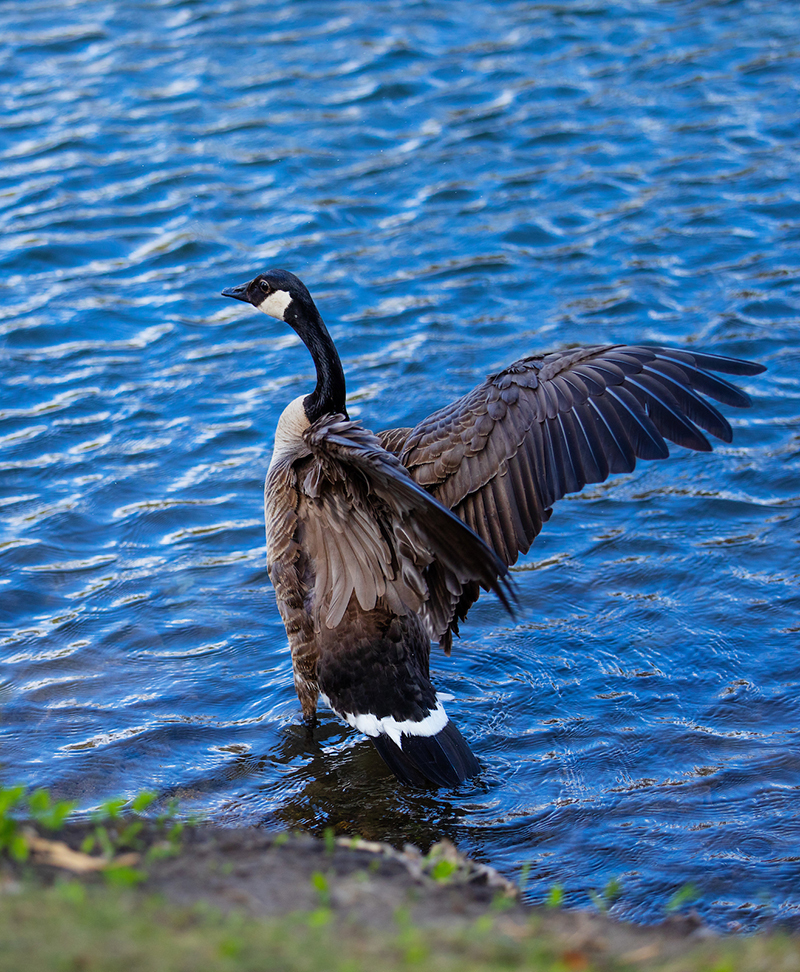
Reducing the impact of the not-so-migratory Canada geese will be a goal of an adaptive Lake LaVerne management plan.
Consultants from Shive-Hattery and Stanec concluded in the fall of 2022 that the two primary issues with Lake LaVerne are water quality and water depth -- on average, less than three feet -- due to decades of sediment buildup on the bottom. In fact, an estimated 43% of the lake's volume currently is a soft, pudding-like sediment, not water. The consultants recommended draining, then mechanically removing the sediment layer to restore the lake to original depths -- up to 12 feet in spots. Deeper water will improve water quality, they noted.
High levels of nutrients, mostly phosphorus, in both the lake water and bottom sediment boost algae and plant production, can deplete oxygen levels and create a toxic environment for fish and wildlife. Twice a year, FPM's campus services team treats the lake with aluminum sulfate, a chemical that suppresses phosphorus in water, cutting off the nutrient source for plants and algae and resulting in clearer water. Those semi-annual treatments are doing the job, according to the consultants. The spring alum treatment was completed April 11, and another is planned in the fall. Because it's a source of phosphorus, removing the bottom sediment also will improve water quality.
According to the consultants, the major sources for phosphorus entering the lake are sediment runoff, waterfowl waste and the well that pumps groundwater into Lake LaVerne. Deepening the lake will help decrease and dilute phosphorus levels. Ongoing lake management would address the well operation and variables such as waterfowl, primarily the Canada geese who reside there year-round, or the future of the aeration system installed in 1998 to maintain oxygen levels in the lake.
The consultants estimate that completing the components in the lake restoration plan would cost about $1 million. Fundraising will be the focus for implementing the plan.
Related stories
- Mute swan Elaine is retiring from Lake LaVerne, Nov. 17, 2022
- A very good reason Lake LaVerne looks a bit soupy, Aug. 25, 2002
National association honors innovators for advancing science
The American Association for the Advancement of Science (AAAS) is honoring five Iowa State researchers for their individual contributions to physics, agriculture, chemistry and engineering. Two of the researchers also are affiliated with the U.S. Department of Energy's Ames National Laboratory.
The latest class of AAAS Fellows includes 502 "scientists, engineers and innovators," all being recognized for "their scientifically or socially distinguished efforts to advance science," according to the AAAS award announcement. This year marks the 150th anniversary of the AAAS Fellows program.
Here are Iowa State's latest AAAS Fellows, their award citations and their current research interests:
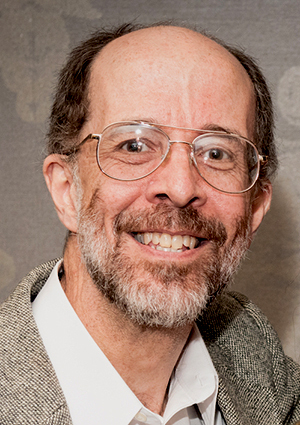
Canfield
Paul Canfield, Distinguished Professor in Liberal Arts and Sciences, the Robert Allen Wright Endowed Professor in Physics and Astronomy, a senior scientist at Ames Lab and a member of the American Academy of Arts and Sciences.
He is being honored "for distinguished contributions to the field of materials physics, particularly for his ability to cook up new intermetallic alloys with exotic properties that provide fundamental understanding."
Canfield's research group focuses on the design, discovery, growth, characterization and mastery of novel electronic and magnetic materials. Canfield's group has been active at Iowa State and Ames Lab for 30 years and is known for its contributions to the fields of superconductivity, magnetism, quantum criticality and correlated electron systems.
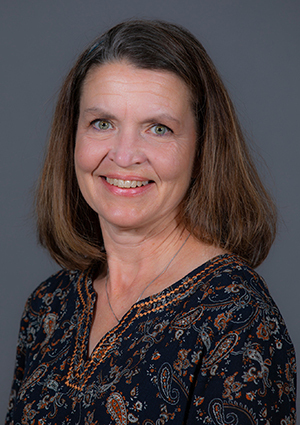
Lonergan
Elisabeth Huff Lonergan, University Professor of animal science
She is being honored "for distinguished contributions to the field of meat science, particularly in early postmortem muscle biochemistry, that have made significant, lasting impacts in sustainably providing nutritious, high-quality protein to the world."
Lonergan's research centers on improving the efficiency of muscle growth and improving fresh meat quality. Her research program uses cutting-edge protein chemistry techniques to find effective, practical solutions for the livestock industry. Challenges addressed by her work include sustainably producing animal-sourced foods to meet the growing global demand for animal protein.
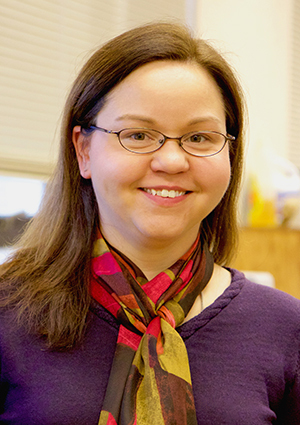
Smith
Emily Smith, professor of chemistry and director of the division of chemical and biological sciences at Ames Lab
She is being honored "for distinguished contributions to advancing the discipline of chemistry by developing new analytical techniques to measure nanoscale phenomena in biomass, energy-relevant materials, and cell membranes."
Smith's research group uses a combination of analytical measurements, instrument development and method development to study three primary areas:
- Biophysical measurements of receptor diffusion to reveal the mechanisms of receptors working together.
- Thin film and nanomaterials characterization related to energy-relevant materials.
- Imaging of biomass to support its use as a renewable source of chemicals and fuels.
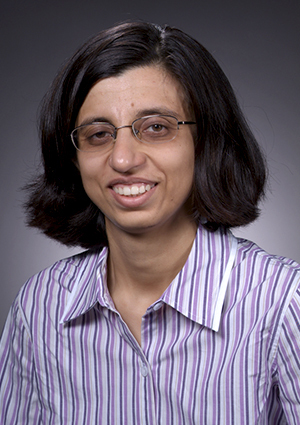
Vaswani
Namrata Vaswani, the Joseph and Elizabeth Anderlik Professor in Engineering
She is being honored "for contributions to the field of statistical machine learning, particularly for dynamic structured high-dimensional data recovery."
Vaswani studies data science, with a particular focus on statistical machine learning, signal processing, and medical imaging. In the last decade, her research has introduced novel online and mini-batch algorithms for structured high-dimensional signal learning problems. More recently, her work has focused on secure distributed learning algorithms. Vaswani also directs the CyMath program at Iowa State.
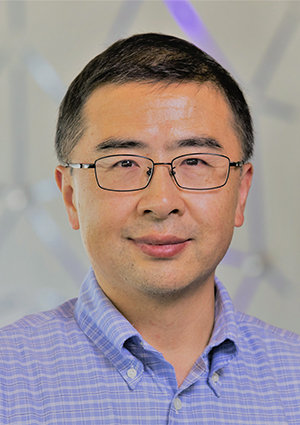
Zhao
Yan Zhao, professor of chemistry
He is being honored "for distinguished contributions to supramolecular chemistry, particularly the development of molecularly imprinted nanoparticles (MINPs)."
Zhao's research focuses on the development of polymeric nanoparticles as synthetic mimics of antibodies and enzymes. These materials can be designed to enter cells to interact with specific target molecules to intervene in biological functions. Some nanoparticle enzyme mimics have been used in biomass conversion to break down cellulose and in plastic recycling.
National celebration this fall
The new AAAS Fellows will be celebrated Sept. 21 at a forum in Washington, D.C. They'll also receive a gold and blue rosette pin (the colors represent science and engineering, respectively). And they'll be named in an April issue of the journal Science.
AAAS was founded in 1848 and is the world's largest general scientific society and publisher of the journal Science and other scientific publications.
Federal changes increase minimum threshold for overtime pay
University leaders are reviewing just-issued U.S. Department of Labor regulations that change overtime pay requirements and will make plans to be in compliance by July 1.
On April 23, the Labor department issued its final rule to change overtime pay regulations under the Fair Labor Standards Act (FLSA). The new rule increases the minimum salary threshold to $43,888 on July 1. The current threshold is $35,568. Under the new rule, the minimum threshold will increase again on January 1, 2025, to $58,656, and then automatic updates to the threshold will occur every three years.
University human resources (UHR) and the general counsel office have begun to review the changes and will develop plans to inform campus on the expected impact. Implementation of the first phase of the regulations is required by July 1.
Under FLSA, employees receive overtime pay -- at least 1.5 times their regular rate -- for work exceeding 40 hours per week, unless the employee's position meets certain standards for exemption. The FLSA outlines these standards for employees who would be considered "exempt" through specific "duties tests" -- and who make at least the minimum threshold salary regardless of time worked. The general counsel office, in partnership with UHR, interprets the standards for exemption and whether they apply to jobs or positions at ISU.
After implementation of the new rule, employees who no longer meet the salary threshold will have their classification transitioned to a non-exempt status, becoming eligible for overtime payments or compensatory time when applicable.
Senators learn more about Cyclone Support
The Faculty Senate learned about the continued development of the Cyclone Support initiative during its April 23 meeting.
The division of student affairs' Cyclone Support initiative aims to boost student success by "increasing student readiness to ask for help and streamlining their ability to connect to care," said Leif Olsen, co-lead of Cyclone Support.
Faculty play a critical role because they are with students in classrooms, labs, learning communities and many other areas, Olsen said. Students who trust their faculty may seek them out when they're in need.
Olsen said one of the most common concerns he hears from faculty is not knowing where to direct students in need and what resources best deal with their issue. The Cyclone Support website, launched in fall 2023, provides help for a range of issues -- for example, academic, mental health and food insecurity. The site has concise information to inform faculty, staff and students. An addition coming to the website will make it easier to coordinate care and define reporting responsibilities for faculty and staff.
"This website addition will help people understand what their responsibilities are and the steps that need to be taken to support students," Olsen said. "We are working to enable faculty to more effectively and efficiently refer students to care using technology that would require no more than 10 seconds."
Olsen said an asynchronous online module in development will help faculty and staff better understand Cyclone Support and practice using it in everyday scenarios.
Faculty and staff with any feedback or suggestions can email cyclonesupport@iastate.edu.
Game design
Senators will vote at the May meeting on a proposed bachelor's in game design in the College of Design. Students in the program would learn how to create and develop video and board games as well as interactive experiences. The degree would be multidisciplinary, incorporating art, storytelling, psychology and technology through courses in several colleges.
One of the "degrees of the future," Iowa State would become the first public, four-year university in the state to offer the major. It would require 63 credits split between core courses, a student's focus area and other areas of game design. Focus areas are: art and interactive media design, game computing, and game worlds, narrative design and society.
New degree
Senators also will vote next month on a proposed bachelor's in education studies in the College of Human Sciences. The degree would serve students focusing on education careers outside of the classroom in settings like museums, zoos or libraries. It would be a non-licensure degree. Coursework would include a semester-long internship.
Academic misconduct
The senate will vote in May on proposed changes to the student academic misconduct policy. The changes are:
- The course syllabus must have an instructor's policy for grading due to academic misconduct.
- Discipline for academic dishonesty is at the instructor's discretion.
- Removes mentions of college-specific policies in favor of a university policy.
College governance
Senators approved changes to the Faculty Handbook's section on college governance documents. Each college's budget advisory council or committee meets and advises the dean, so the council or committee must include the college's senate representative from the resource policies and allocations council in addition to faculty from multiple departments.
Elections
The senate re-elected two council chairs and a new secretary:
- Governance council: Matt Frank, industrial and manufacturing systems engineering
- Judiciary and appeals council: Steve Freeman, agricultural and biosystems engineering
- Secretary: Ryan Bhattacharyya, management and entrepreneurship
P&S CYtation recipients recognized for extraordinary service
At a March 26 ceremony, 47 employees received the Professional & Scientific (P&S) Council's CYtation Award for their outstanding work and contributions in calendar year 2023.
The CYtation awards recognize P&S employees, particularly those who might not otherwise receive public recognition, who go above and beyond the call of duty, do something extraordinarily well, and act in such a way as to make a real difference in the institution. More information about the recipients is on the council's website.
Council president Patrick Wall presented the awards.
The Woodin CYtation Award, created in memory of former council member Dan Woodin, recognizes a career of dedication and service to Iowa State. Recipients receive a framed certificate and a gift donated by one of the council's ISU partners: ISU Athletics, ISU Book Store or Reiman Gardens.
CYtation award nominations open in October. Individual awards recognize an achievement within the last two years, and team nominations recognize achievement within the last year.
Professional and Scientific Council Woodin CYtation Award recipient
- Deb Vance, international students and scholars office
Professional and Scientific Council CYtation Award recipients
- Whitney Baker, student academic services, College of Liberal Arts and Sciences
- Amanda Brockman, office of biotechnology
- Carla Harris, graduate student services, College of Agriculture and Life Sciences
- Amro Hashish, veterinary diagnostic and production animal medicine
- Jeremy Kellen, audio visual support, College of Veterinary Medicine
- Mary Jane McCunn, human development and family studies
- Dawn Miller, civil construction and environmental engineering
- Chris Myers, ecology, evolution and organismal biology
- Sonya Nichols, Center for Excellence in Learning and Teaching
- Yamille Perez, student services, College of Engineering
- Heidi Pontinen, student counseling services
- Elizabeth Richards, Iowa Statewide Urban Design and Iowa Public Works Service Bureau, Institute for Transportation
- Abbie Suntken, office of the registrar
- Ron Sykora, office of the registrar
Professional and Scientific Council CYtation Team Award recipients
- Center for Communication Excellence team, Graduate College: Sarah Huffman, Kristin Terrill and Lily Compton
- Instruction Services team, University Library: Kate Garretson and Emily Simmons
- Master of Professional Practice in Dietetics team: Leanne Lauber and Anne Packard, food science and human nutrition
- Seed Lab team, Seed Science Center: Drew Miller, Natalie Jacobson, Will Zastrow, Jessica Blake, Brooklynn Aamodt, Kaitlin Metzger, Susan Souhrada, Charles Block, Day Carrera, Daniela Avalos-Ochoa, Tess Howard, Michael Stahr, Kim North, Derrick Mayfield and Gabriela Morel-Gadea
- Workday Learning implementation team: Steven Couchman, Mindi Balmer, Raji Sivasubramanian, Autumn Schwartze, John Twitchell, Kelly Walker, Melody Rudolph, Nathan Hannover, Ruth Schlotfeldt and Tom Connolly
Innovation at work: By the numbers
Editor's note: This feature is the sixth in news service's 2024 Innovation at Work series of stories, photos and videos that highlight economic development and the impact of Iowa State's contributions across the state.
Iowa State's Economic Development and Industry Relations team, in partnership with ISU Extension and Outreach, is focused on innovation and economic prosperity that extends beyond campus to all 99 Iowa counties. Through collaboration, exploration and research, Iowa State is making a difference helping grow business, preparing the future workforce and fostering entrepreneurship.
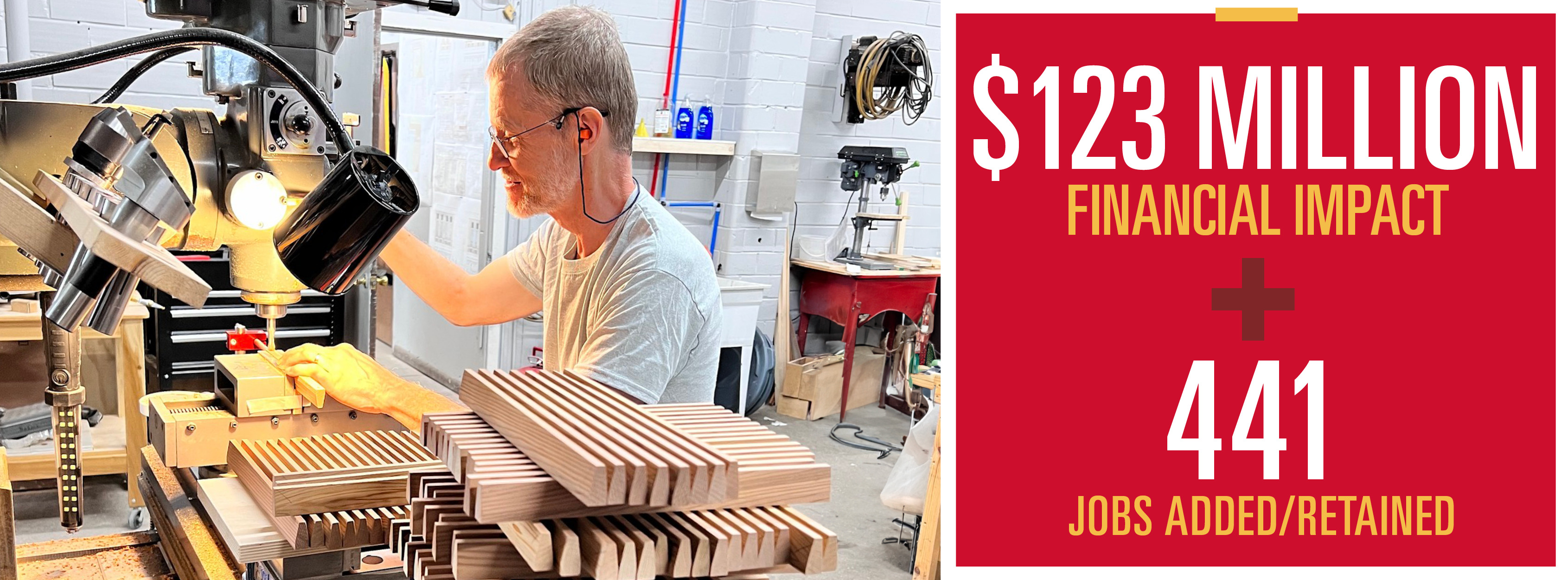
That's the statewide impact of the support Iowa State's Center for Industrial Research and Service (CIRAS) provides to businesses through the Iowa Economic Development Authority's Manufacturing 4.0 Technology Investment Grant program.
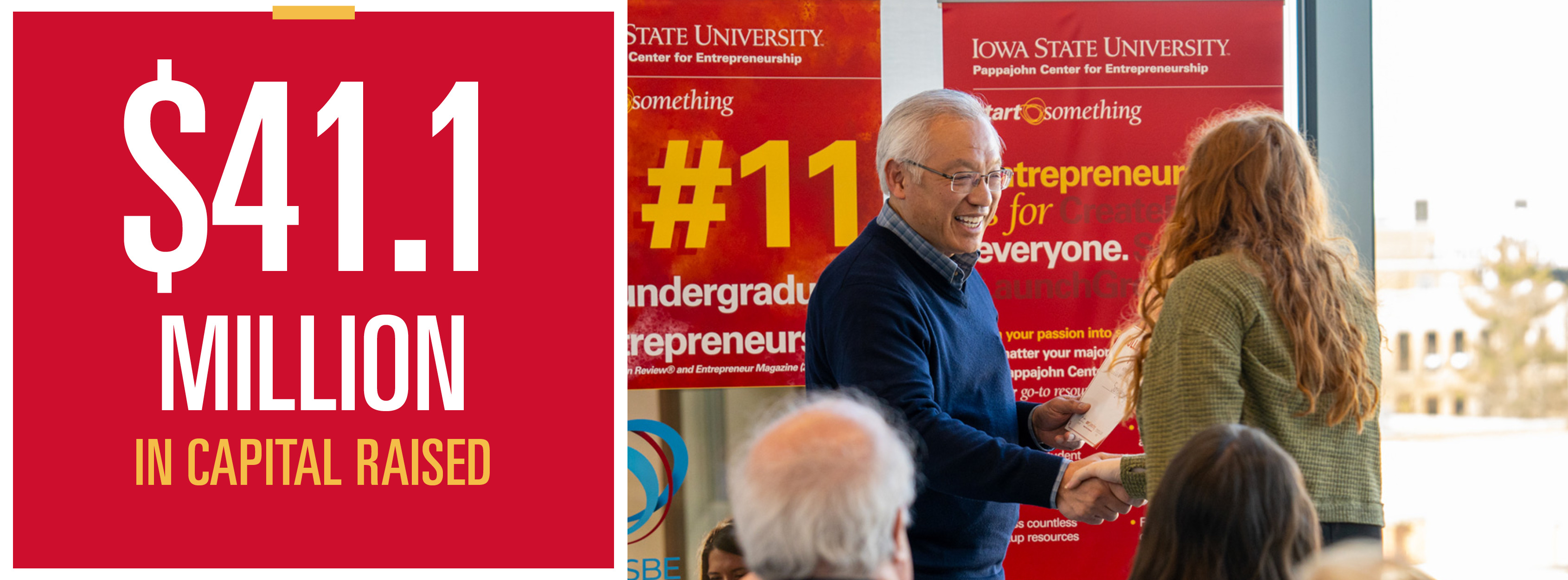
Iowa State's flagship entrepreneurial programs are one reason Iowa State was named Entrepreneurial University of the Year for the Americas. What does that mean for the state? In 2022-23, the Pappajohn Center and local SBDC served 1,423 clients, which led to 63 new ventures, 362 jobs and $41.4 million in capital raised.
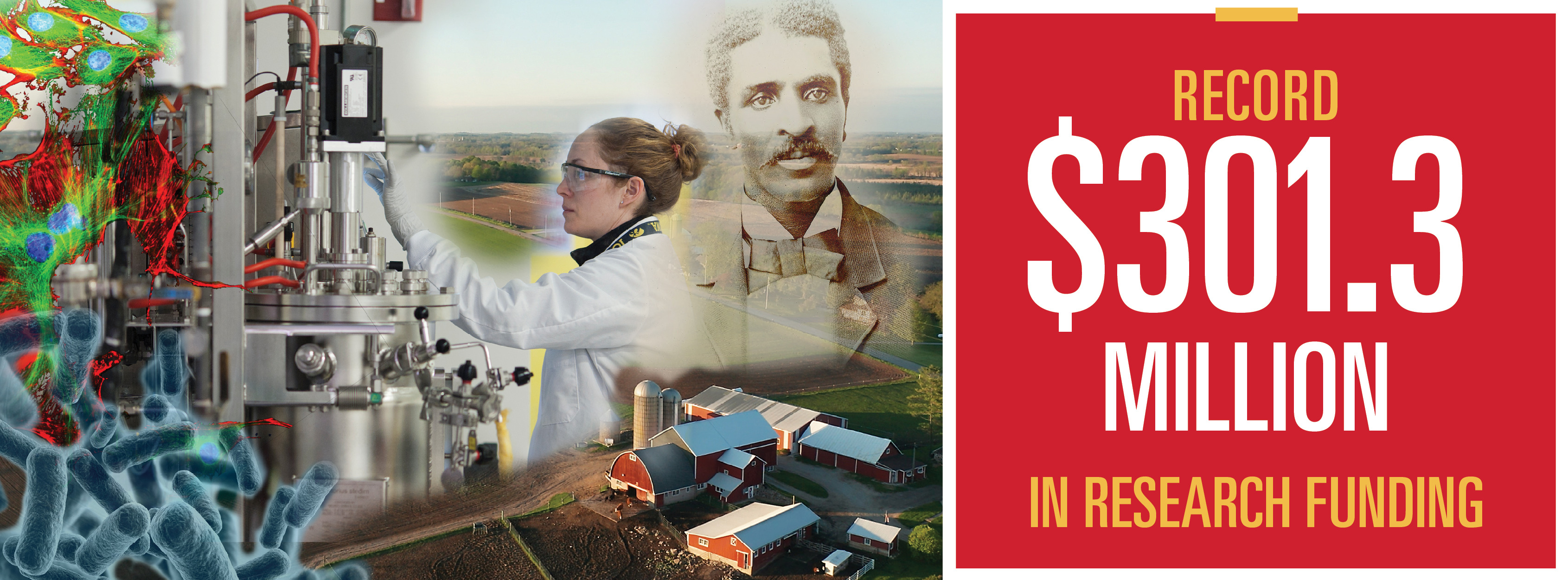
External support for Iowa State research has far-reaching benefits, including a $20 million grant from the National Science Foundation to create the technologies and develop the workforce to build and grow advanced biomanufacturing capacity in the state.

The Small Business Development Center for Iowa supported 4,569 companies across the state with business growth strategies, financial analysis, export assistance and other services in fiscal year 2023. In addition to jobs and business starts, this support equaled $111.1 million in new capital and an increase of nearly $154 million in sales.
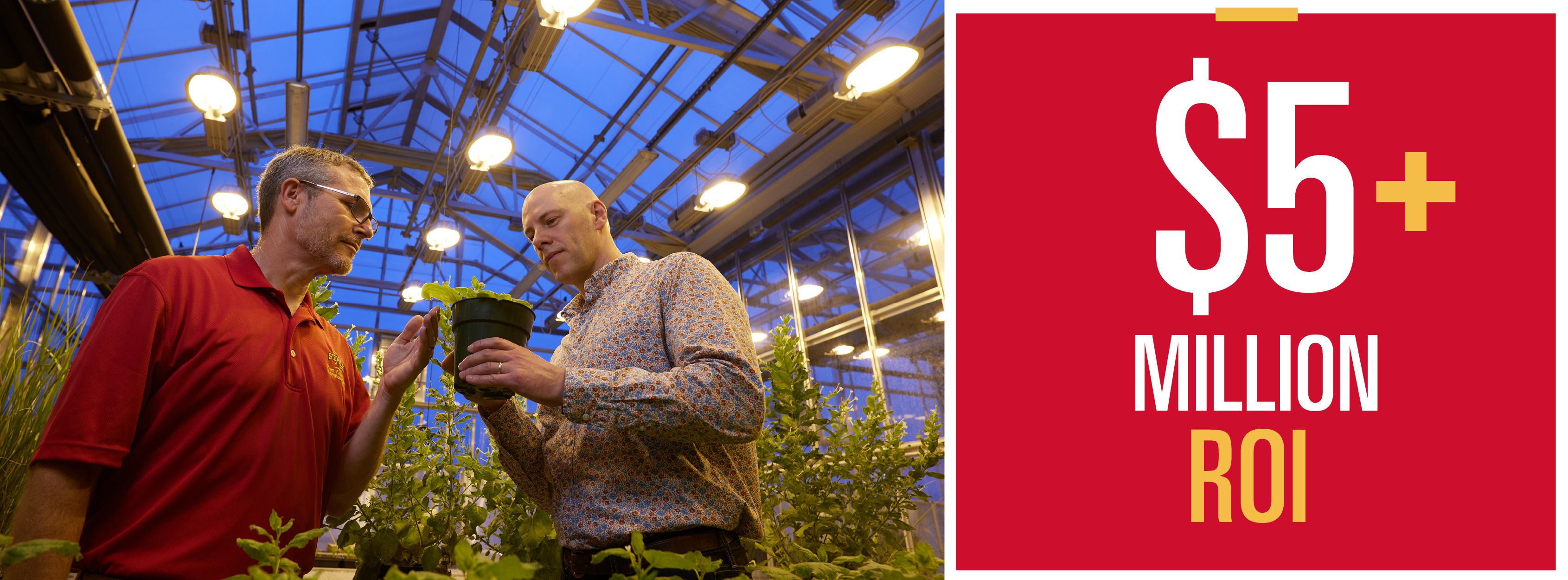
That's the return on the $2.6 million invested by the state for fiscal year 2023 to support Iowa State's research and development efforts across three Biosciences platforms. In addition to leveraging federal dollars, the funding provided seed funds to university startups for scale up opportunities.
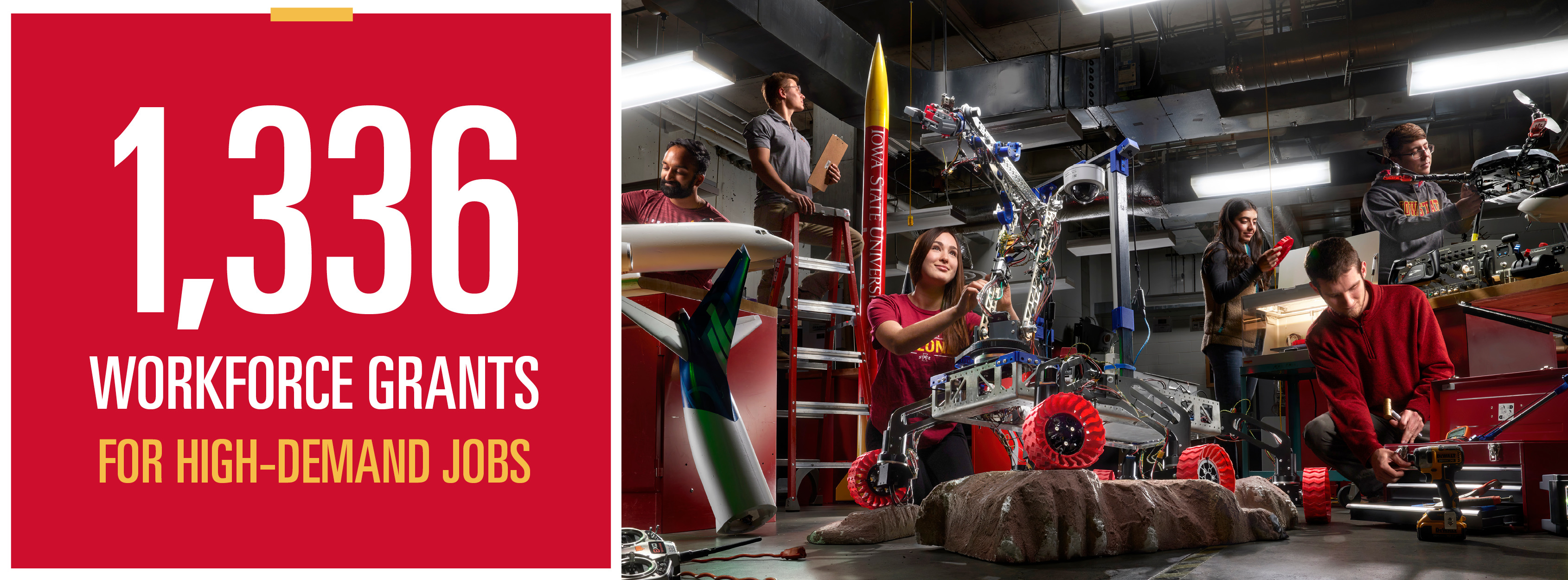
More than 60% of Iowa State students major in a STEM field. The Workforce Grants prepare students for high-demand jobs in Iowa. Nearly 70 ISU degree programs fit the criteria for Workforce Grants authorized by the Iowa Legislature in 2023.
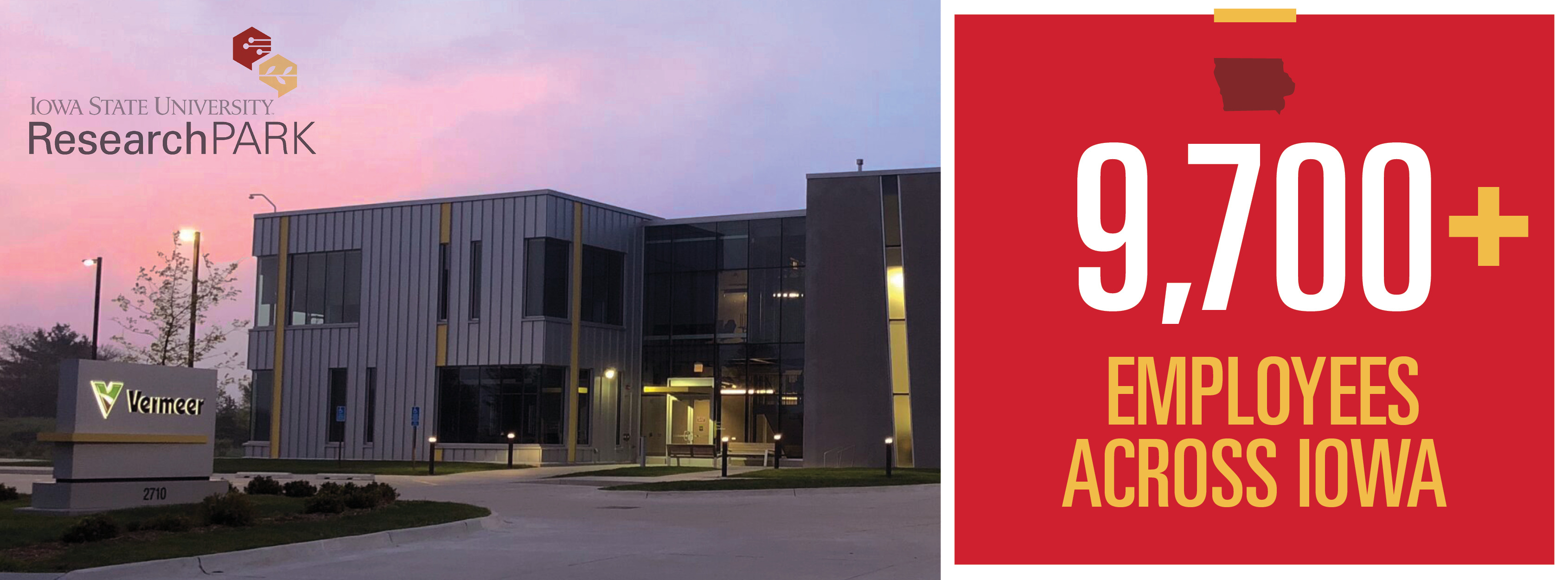
The ISU Research Park is home to 131 companies and nearly 2,500 employees. Another 9,709 employees are located in communities across the state working for companies in the research park.
Good boys and girls
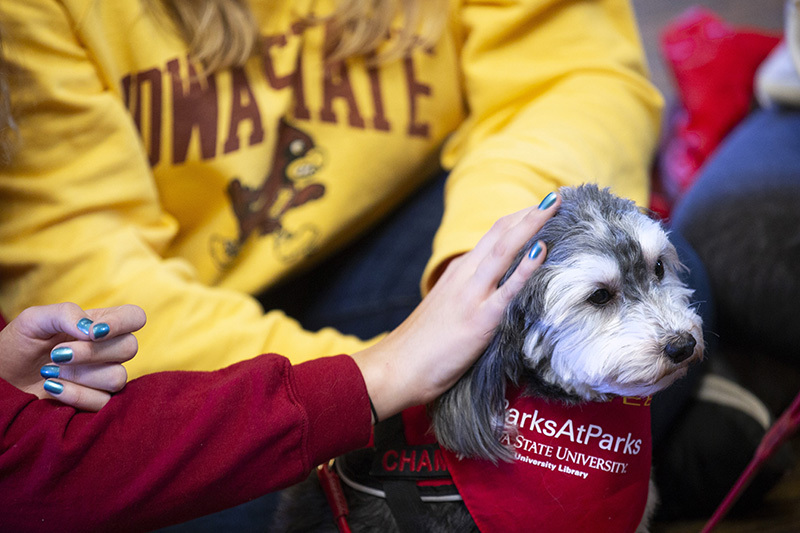
A student pets a pooch during 2019's Barks at Parks, where dogs joing Iowa State students as a fun strategy for relieving stress during prep week. Photo by Christopher Gannon.
This academic year marks the 10th anniversary of the first Barks at Parks, when certified therapy dogs come to Parks Library's upper rotunda for some attention -- but really to help students relax during prep week. The dogs will return this semester from April 29 to May 3.
The therapy dogs first visited Parks in the fall of 2014, but the event did not receive its name, Barks at Parks, until May 2015. Brendan Finan, then a sophomore computer engineering student, submitted the name during a Facebook contest. The pandemic suspended the event for three semesters: spring and fall 2020 and spring 2021.
